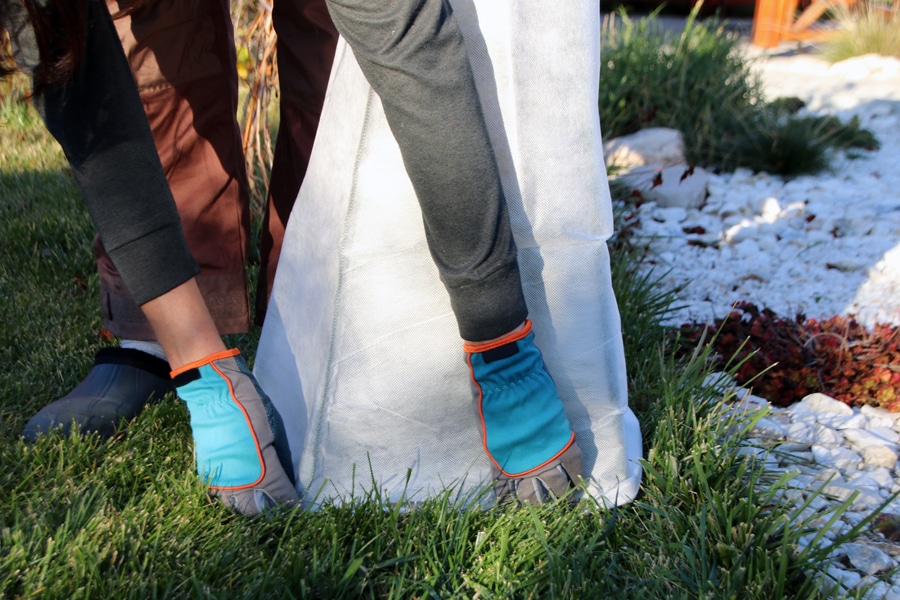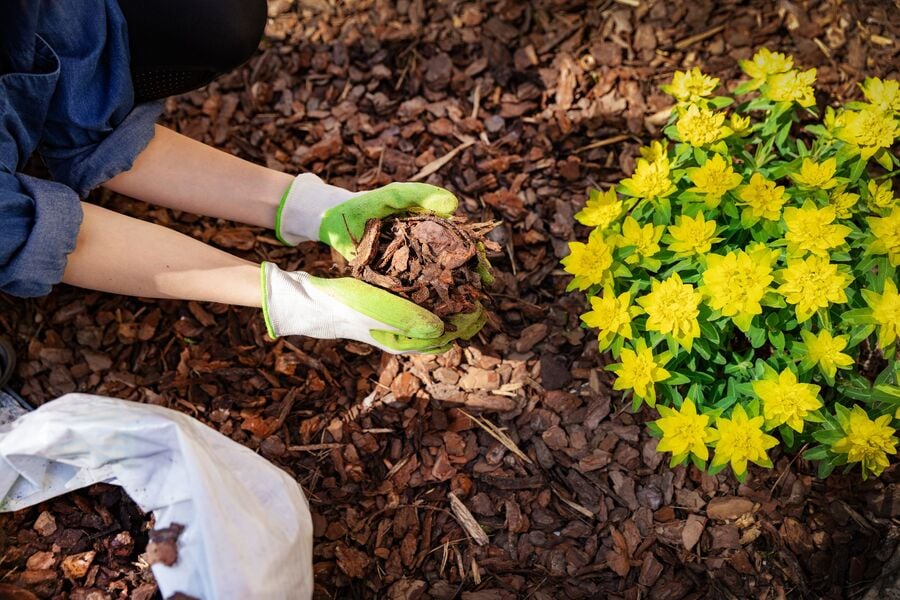Winter weather is damaging, especially in the Southern United States. Unexpected cold snaps and temperatures changing sharply can take their toll on your plants in the landscape. When you hear the weather report calls for freezing temperatures overnight, you will end up panicking trying to find a way to cover your beloved plants and by that time it’s probably too late.
It’s better to prepare!
What plants need to be covered in winter?

Though there are some best plants for winter gardening, not all plants are as hardy. Here are some of the plants, trees and shrubs that need a little more insulation, covering, or attention during the winter months:
1. Tender bulb flowers
Many bulb flowers, such as daffodils and tulips, are able to stay underground during a hard winter and easily return during warmer weather.
However, there are many tender bulb flowers that cannot take freezing temperatures and it doesn’t matter where they are planted. Dahlias, begonias, and freesias will die if the bulbs are left out in the cold.
2. Delicate trees
Newly planted trees are really vulnerable during freezing nights. Other trees considered delicate, no matter their age, are citrus trees. Citrus trees can easily be damaged after a sudden freeze.
3. Tropical plants
Tropical bulb plants should be cut back, dug up, and stored during the winter season. Larger tropical plants, like hibiscus and aloe, will not easily survive super cold temperatures.
Potted plants are easy to be brought indoors at night but if they are planted on the ground then keep them trimmed and covered every night with a plant-safe cover.
4. Annual plants
Many fruits and vegetables that are grown as annuals can’t survive freezing nights. Some of these plants can be collected for seeds during the winter for replanting in the spring and summer.
Crabgrass, petunias, and snapdragons are types of annual that will not survive cold weather and will need to be taken care of to survive.

When should you cover plants in cold weather?
As a gardener who worked so hard on your beautiful garden, it is important to know when you need to take steps to preserve perennials and harvest annuals so the cold weather will not destroy them.
1. Know the dates!
First things first! Know your local average frost dates – first frost (Fall) and last frost (Spring).
As the temperatures continue to cool in Fall, usually about a week or two later, the first freeze date of the year will occur (and, usually kill your beloved plants). For example, Missoula’s first frost date is September 22nd, and the first freeze day is in mid-October.
In the spring, as temperatures begin to warm back up, the last day of the year we can expect a frost is the last frost date.
Here is a great winter frost zoning map by the USA government to help you specifically locate your first frost day in your region. Very helpful!
2. Limitations
These dates are based on historical weather data collected over a 30 year period, so they are usually accurate but by no means exact. It is important to remember that these dates are simply estimates and cannot account for unusual weather events. For instance, an abnormally warm spell during the cold season or a sudden onset of cold before the estimated first frost date will cause damage to certain plants, so you need to pay attention to weather warnings before spring to make sure you are able to mitigate the damage.
So, be diligent, check the weather report regularly or set up a weather app alert to keep an eye on the overnight lows.
3. Assess how bad it is
It’s not just the winter temperatures but the length of time that temperatures are at or below freezing that damages plants.
Keep this in mind along with several key definitions listed below when evaluating the severity of the weather report.
Frost Advisory – This is when the temperature is expected to fall to 36 degrees -32 degrees Fahrenheit.
Freeze Warning – This is issued when there is at least an 80% chance that the temperature will hit 32 degrees Fahrenheit or lower.
Light freeze – 29° to 32° Fahrenheit will kill tender plants.
Moderate freeze – 25° to 28° Fahrenheit is widely destructive to most vegetation.
Severe or hard freeze – 25° Fahrenheit and colder causes heavy damage to most plants.

How do I protect plants in the winter?
1. Get the right planter
Getting the right container is the first step in protecting plants in winter. Fiberglass is the best material for plant protection. Garden centers will attest to that, they are some of our biggest customers of fiberglass planters!
Not only do fiberglass planters keep plants warm, but they also provide plant protection when the rest of the ground freezes. When drainage holes are installed, the risk of root rot is far lower than with garden plants in the ground. Plus they are the best way to transport your beloved plants, trees and shrubs into warmer areas when trying to avoid winter damage because fiberglass is lightweight and strong.
2. Add a Layer of Mulch
Mulch is a garden miracle-worker any time of year and an important part of winter care. It’s like a blanket that covers your plants.
A common winter problem is heaving or uplift of soils caused by freeze-thaw cycles. Soil heaving can literally push shallow-rooted plants like Heucherella and Gaillardia out of the ground, exposing the tender crowns and roots to freezing temperatures.
Mulch is used to keep soil temperatures consistent by maintaining soil moisture and insulation. When soil is wet, it’s much harder to freeze solid.
Give your plants a quick watering and apply a thick 3- to 5-inch layer of mulch after the first frost. The best materials are lightweight, such as chopped leaves and pine straw, because they won’t compact.

3. Winter Watering
During the winter months, trees lose a great amount of water (unless there is enough rainfall), especially during windy days, it is vital to provide supplemental irrigation at least once per month to keep soils moist.
Soil moisture also protects both dormant and evergreen plants during cold snaps. Moist soils hold more heat than dry soils, so the potential damage to plants’ roots during the cold weather increases if the soil is dry. Keep an eye on plants in containers, they are usually drier than plants in other areas.
4. Bring potted plants indoors
The first and easiest solution to the cold is to simply remove your plants from the low temperature.
If you have any potted plants or hanging baskets outdoors, bring them inside your home. Even a move to the garage or a sunroom will be beneficial, as this will still increase the temperature by at least +10ºF. If possible, the best solution is to place your plants around the interior of your home as decoration.
5. Cover your plants
This method works best to protect from frost rather than cold temperatures, as the covering won’t increase the temperature too much. Oh, and remember to take it off during the day so that the plants can get enough light from the winter sun.
What should we use to protect plants?
Mulch is great for covering the base of the plant. Bed sheets or comforters work best for covering large plants and shrubs. Newspaper can be used on low-growing foliage, but it can often be difficult to get it to stay in place. You can also use old pillowcases, sheets, towels and even cardboard boxes.
Plastic can be used but it is important to note that you should not let the plastic touch your plants. Plastic that touches your plants can often be even worse than no protection since it can hold moisture against plant tissues and cause more serious freeze damage
6. Build a cold frame or greenhouse
Build a simple, temporary cold frame that will trap heat and block out frost. It is the best solution for keeping your young and tender plants safe and warm in the winter. However, it does require a bit of construction and is not the most attractive solution.
With just a few inexpensive and reclaimed materials, a drill, some screws and a screwdriver, it’s straightforward to make your own cold frame to protect plants from the elements.
Here is a great Youtube video to learn how to make one.

How do you revive a plant that’s too cold?
After the cold has passed, gentle watering can help rehydrate plants that are drought-stricken from frozen ice, but avoid overwatering that would stimulate new growth and stress an already weakened plant.
It’s important to avoid unnecessary fertilization because although the fertilizer will stimulate new growth, your plant is unlikely to be able to handle it after being damaged. Just keep the plant hydrated to stimulate a gentle recovery.
Even the most tender, delicate plants are more hardy than we realize, and they are often able to recover from cold snaps we would assume to be deadly. By recognizing cold damage and knowing how to revive plants without causing further stress, it is possible to protect and nurture every tropical plant in your garden and landscape, even when the weather isn’t quite the tropical climate they may prefer.

Q&A
Can I use black garbage bags to cover plants from the cold?
The answer is no! As mentioned above, never use plastic of any kind, including black plastic garbage bags, to cover plants, as plastic conducts cold to the leaves and will increase the likelihood of damage to the plant.
What if the covering is not enough?
If the forecast is for the temperature to be well below freezing, a cover might not be sufficient. In this case, you will need to provide extra warmth.
Using Christmas lights under the cover will help but make sure you are using the old fashioned incandescent lights, as LED and mini-lights do not give off enough heat to make any difference.
Snow is all over my plants, what should I do?
For larger plants and trees, knock snow off whenever you can.
To avoid damaging the plant, try using a soft-headed broom to wipe off heavy snow. The longer the snow is in contact with the foliage, the more likely the plant will suffer. Snow is also heavy, so if you can knock it off as often as possible, the risk of broken foliage is reduced.
What kind of mulch should I use?
Select an organic mulch to add nutrients to your lawn.
Organic mulches include wood chips, straw, grass clippings, chopped leaves, and compost. When the mulch breaks down, it naturally adds nutrients to the underlying soil. Organic mulch will also help with water retention, weed prevention, and will protect plant root systems. Organic mulches won’t, however, protect plants from pests.
When can I move potted plants inside?

It is also very tempting to move container plants indoors or provide strong supplemental heat to warm them up after a cold shock, but doing so can actually shock plants even further.
You can try moving them indoors if the cold period is lengthy or an even colder temperature are predicted but allow them to adjust to their new surroundings very gradually to minimize any quick changes that can irritate already stressed plants. Try putting your plants in a garage, shed, or sheltered location to let them warm up a bit first.
Protecting plants in winter is a challenge, we hope that the article can help you keep your plants healthy and protected in the winter.
The last step is to start browsing for that perfect planter or get them wholesale before winter really starts to set in!
